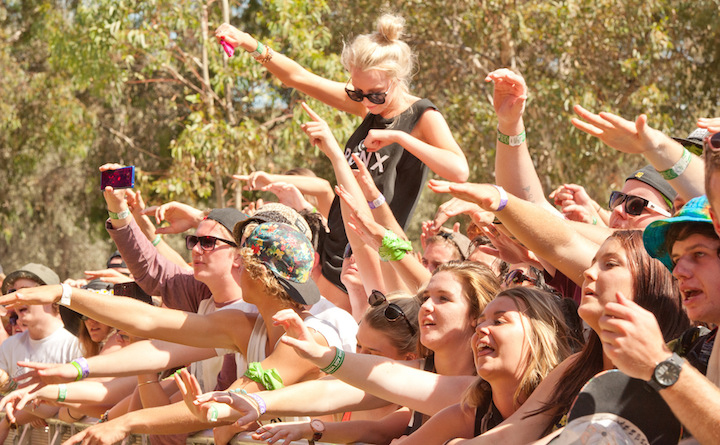
Jabberwocky, scheduled to take place last weekend, was the kind of festival that wasn’t supposed to fail. Its pedigree was impeccable: presented by an international festival organisation (All Tomorrow’s Parties), with help from one of Europe’s largest and most successful festivals (Primavera Sound), and a principal online musical taste-maker (Pitchfork). Its impressive lineup featured the sorts of cult acts that have become synonymous with ATP’s brand, including Neutral Milk Hotel, James Blake, and Caribou, as well as more recherché acts such as Earth, Vatican Shadow, and Chelsea Wolfe. Yet fail it did—a mere three days before the festival was scheduled to start, ATP announced that it had been cancelled. To say that the fallout has been acrimonious would be an understatement: both the festival’s ticketing agent and publicity firm have launched lawsuits against ATP, and Pitchfork has taken the unusual step of issuing a statement distancing themselves from the festival’s financial arrangements. (For their part, Primavera have simply deleted the event from their website.)
Jabberwocky isn’t the only high profile music festival casualty of late. Closer to home, the iconic Big Day Out festival recently and somewhat belatedly announced that it would not be hosting an event in 2015. According to promoter A.J. Maddah, the festival will instead be focusing its efforts on its 2016 offering. This may not necessarily spell the end of the Big Day Out—it went on hiatus in 1998, and returned the following year to absolutely dominate the Australian festival landscape for the next half-decade. But, as one eagle-eyed punter on FasterLouder’s forums noted, Australian festivals have a habit of going on hiatus and simply never returning. Such was the case with Livid (post-2003), V Festival (post-2009), and both Pyramid Rock and Homebake (post-2012).
Festival failures are not exactly unknown on the Australian circuit—regular readers of Mess+Noise might gleefully remember the disastrous Blueprint festival of 2009, whose organisers were bankrupted by their own poor management, and BAM!, a 2010 festival that didn’t so much resemble a fun weekend away as a pyramid scheme. In the past, however, it was usually greenhorns whose festivals folded or ended in catastrophe. This is evidently no longer the case.
Of course, the reason why each of these festivals has failed remains unique to that festival; there is no common cause for the general malaise. In the case of Jabberwocky, it must be mentioned that ATP have a relatively chequered history of delayed and cancelled festivals, including a Jeff Mangum–curated instalment of their core All Tomorrow’s Parties festival that was scheduled to take place in 2011, but postponed to 2012. Another instalment curated by Jim O’Rourke and scheduled to take place in Tokyo in 2012, was first postponed and then cancelled. Their Australian festival offerings have been patchy, to say the least—an instalment of ATP curated by Nick Cave and the Bad Seeds at Victoria’s Mt. Buller in 2009 was exceptionally well-received, but an instalment of its I’ll Be Your Mirror series at Altona in 2013 was plagued with problems, and ticket sales for a one-off follow-up event called Release the Bats were so lacklustre that the event had to be moved to two smaller venues in St Kilda.
The failure of the 2014 Big Day Out seems to stem from its audacious use of three major headliners: Pearl Jam, Blur, and Arcade Fire (BDO promoter Ken West called the triple headliners three ‘white whales’ when announcing the lineup—perhaps unaware that Moby-Dick’s white whale actually kills Captain Ahab). Aside from the logistics of dealing with three stadium-sized bands and their stadium-sized egos—the festival was planning to construct an extra main stage to accommodate all three without clashes—each band caused its own problems. Pearl Jam may have appealed to an older, nostalgic crowd, but those who purchased tickets just to see them let the organisers know they were only attending the BDO under sufferance (there were no sideshows). Arcade Fire had toured with the BDO previously in 2008, which made them a known quantity, and the release of a somewhat bloated and indulgent fourth album (Reflektor) had dulled their appeal. The protracted dispute between Blur and the BDO’s management ended with Blur pulling out of their headline slot. The BDO replaced them with three separate acts (The Hives, Deftones, and Beady Eye) compounding the event’s general state of confusion. The end result was an overstuffed festival bill with little coherence—one that generated a lot of internet chatter, but ultimately lead to disappointing sales.
The failure of these two high-profile festivals drives home a key message: the festival boom is definitely over, and we’re well into a period of festival crunch. The festivals that are likely to survive are ones that are small and agile, have well-defined target audiences they know intimately, and can respond swiftly to both musical and logistical developments. Most importantly, those festivals that wish to succeed in an environment where the 18–25 age bracket is no longer flush with cash will need to chase older, more moneyed audiences—and those audiences tend to prioritise about the overall experience of the festival rather than individual acts. The superabundance of festivals in the previous decade has given older audiences (25–35) some very high expectations: we want not only well-curated music but also nice amenities, an absence of long queues, decent food and drink, and not to be treated like potential drug smugglers on our way in by security and police. A small number of boutique festivals will be able to deliver such experiences, but until the economic good times return, expect the larger festivals with their quantity-over-quality format to struggle.